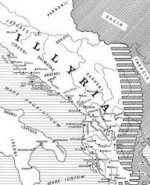I am afraid to even read all the stupidity that it might have been written here thru 40 pages...
Albanians are mostly whats left of Illyrians, Albanian language also testifies to this. Genetics also confirms it.
By my free estimate more then 90 % of Illyrian ethnos vanished in bottleneck or assimilated in other ethnos then Albanian.
Albanians after fall of Roman Empire started to form of whats left of Illyrians, and as we all know by history Illyrians were in that time migrating and redrawing to South where now Albania is.
However about 70 % of Albanian Y lines we can connect with Illyrians (Indo-Europeans) and whats left of them, Illyrian-Thracian-Dacian-Hellenic heritage.
Out of rest of 30 % of other lines, about 13 % are Slavic. Rest in minority are Germanic, Middle Easterner, Pelasgian, Roman, Neolithic/Paleolithic European, and plenty of others..
Out of three major Albanian haplogroups, R1b, E-L618+v13, and J2b-L283. E-L618+v13 have probably longest presence from West to Central and Southeast Europe according to ancient DNA (Neolithic). However main expansion (TMRCA 4800 years), happened with Indo-Europeans (Bronze Age) from East Europe, and probably later also with Thracians and Illyrians thru Roman Empire as there we find epicenter of Balkan E-v13.
Also last wave must be with new age Albanian/Romanian/Bulgarian/Montenegrin and other nations with High E-v13 that assimilated into Brits, Americans, Italians, and others.
I would also like to give a hint to beginners, that we are only generally talking here, as every of these main haplogroups later branches out in many smaller clades that are distant in thousands of years one from another. So for more advance approach it would be good to analyse clade by clade. However this is just general analysis and it is also correct to analyse in this way if you know what you are doing and if you have backup evidence like in ancient DNA for example.
Albanians are very Indo-European population, and its clear that genetically they are closer to Greeks and Italians then to Middle Easterners, Slavs, West Europeans or anyone else for that matter. Albanians are just as MyOrigin FTDNA calculator displays, where we have confirmation from FTDNA technician that it goes 2000 years back in traces. By my free estimation in MyOrigin Albanians are over 95 % Southeast European in cluster with Greek and Italians. Further Northeast are Bulgarians and Serbs - they are in middle of way to Albanians/Greeks and North/East Slavs because they are mix of real Slavs and Balkan native population.
Example:




